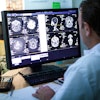
The latest effort to avert cuts to Medicare physician payments mandated by the sustainable growth rate (SGR) formula may be another in a long line of temporary fixes, but it also represents a victory for radiology, with language mandating the use of appropriateness criteria, transparency around payment policy, and radiation dose management.
On April 1, President Barack Obama signed into law a 12-month patch for the SGR: HR 4302, the Protecting Access to Medicare Act of 2014. The bill again delays a payment reduction for physicians and other practitioners who treat Medicare patients, replacing a 24% cut with a 0.5% increase in payments through December of this year and a 0% update from January 1 to March 31, 2015.
Although medical associations criticized Congress for failing to follow through on a permanent SGR repeal -- this bill is the 17th short-term Medicare SGR patch over the past 11 years -- the American College of Radiology (ACR) praised parts of the measure. ACR noted that the legislation requires ordering physicians to consult appropriateness criteria when ordering advanced imaging procedures for Medicare patients, and it directs the secretary of the U.S. Department of Health and Human Services (HHS) to identify clinical decision-support tools to help physicians do so.
"For the first time, appropriateness criteria language has been included in legislation like this," Cynthia Moran, ACR executive vice president for government relations, told AuntMinnie.com. "This issue has been our highest legislative priority."
Other wins include the U.S. Centers for Medicare and Medicaid Services (CMS) having to release the data it used to establish its controversial 2012 multiple procedure payment reduction (MPPR) policy for the professional component of imaging services, as well as a provision mandating that any cuts to particular codes greater than 20% will have to be phased in over two years, Moran said.
"We're fairly certain CMS didn't use a lot of data when it developed the MPPR policy, and now we'll be able to go back to Congress -- or the courts -- to push back," she told AuntMinnie.com.
Coming to a hospital near you: Clinical decision support
By November 2015, the HHS secretary must, through rule making, specify applicable appropriate use criteria for imaging services, using guidance from national professional medical specialty societies or other provider-led groups.
"Appropriate use criteria" means criteria developed to assist ordering professionals make the most appropriate treatment decision for a specific clinical condition for an individual. Such criteria must be evidence-based to the extent feasible, according to the bill.
By April 2016, the secretary must designate a clinical decision-support mechanism that will allow appropriateness criteria to be implemented. The clinical decision-support tool must meet the following requirements:
- Make clear to clinicians the appropriate use criteria for advanced imaging
- Determine the extent to which the ordered imaging service is consistent with the appropriate use criteria
- Be updated regularly to reflect revisions to appropriateness criteria
- Provide feedback to the ordering doctor
ACR will urge HHS to incorporate its ACR Select tool, which was developed in 2012 as a joint project between the organization and healthcare informatics software developer National Decision Support Company. Physicians ordering imaging exams through their computerized physician order-entry (CPOE) software encounter ACR Select whenever they are choosing an imaging exam for a patient. ACR Select applies a numerical score and color code to the exam based on appropriateness criteria, with questionable exams coded in red, appropriate exams in green, and yellow for those in between.
"We will make the argument that ACR Select should be included," Moran said. "We've been developing appropriateness criteria for more than 20 years, and ACR Select is by far the most comprehensive and evidence-based tool."
HR 4302's appropriateness criteria rule will go into effect on January 1, 2017. Physicians will only be paid for advanced imaging exams if claims include information about which clinical decision-support mechanism was consulted and whether the service ordered adheres to the criteria -- or if the criteria are not applicable, according to the bill's text.
Those who have trouble complying with appropriateness criteria will be subject to a preauthorization process. Beginning January 2020, the secretary will apply prior authorization for applicable imaging services that are ordered by an outlier ordering professional.
"The threat of preauthorization should be a huge incentive for physicians to use decision support," Moran said.
Radiation dose language
Language on radiation dose also crept into the SGR legislation. The law states that for all imaging studies performed on CT equipment out of compliance with the National Electrical Manufacturers Association (NEMA) 2013 dose management standards, payments will be cut by 5% in 2016 and by 15% in 2017 and subsequent years.
"The ACR worked closely with the manufacturers to impose a more gradual penalty into this policy," Moran said. "And we're encouraged that most CT equipment will be able to meet these compliance standards, certainly by 2017."
HR 4302 is another temporary fix to the ongoing problem of reconciling the SGR with Medicare physician payment rates, but it does bring a bit of good news after years of challenges to radiology, according to Moran.
"Radiology has been on the receiving end of every bad public policy initiated by Congress and CMS for the last several years," she said. "It's nice to finally see some positive results."




















